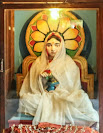The Colors of Mithila
This year would be the second Holi washed out by covid. The vaccine is out and many of us are starting to get it, which is building some level of confidence towards a path to normalcy. It is still not enough for people to engage in the regular color play, which is the essence of Holi. Given the restrictions, I decided to indulge in colors in a different way, by revisiting the colorful and vibrant Indian arts.
A few years ago I had the opportunity to attend a unique exhibition of Madhubani or Mithila Art right here in Acton. I knew about this dedicated Madhubani Teacher-Disciple duo, Sunanda Sahay and her student, Anindita Lal, who had worked together for a Massachusetts Cultural Council program, and showcased her work at the Acton Discovery Museum, among other places. The exhibition, which presented the very traditional Mithila Ram-Sita wedding painting, to the intricate and brightly colored designs with birds and foliage, also showcased an unconventional piece of Aladdin on the magic carpet. It was fascinating to see a traditional painting technique being applied to a very contemporary story. “Mithila is a storytelling form - it is simply a different medium than words. I encourage my students to express any story of their choice through this form. Anindita’s rendition was Aladdin on the magic carpet.” says Sunanda. For some of the paintings, Anindita had created dyes from flowers. I was reminded of the way some organic colors for Holi are made with Tesu (Palash), Parijatak or Hibiscus.
My first introduction to Mithila Art was about a decade ago, when I stepped into Sunanda’s home, which was beautifully adorned with very traditional looking paintings. Curiosity got the better of me, and upon asking I learned that the artist of the intricate Madhubani paintings was our host, Sunanda Sahay, herself! Indians in the Western world usually conjure up a popular image of Bharatnatyam, or Garba or Bhangra dancers; lavish weddings in grandiose dresses and sarees; Bollywood movies and delectable, spicy cuisines. Occasionally they bring forth images of the magnificent architecture of the Temples across North America or Indian Classical music recitals. On the academic side, Indians are known in the Spelling Bee circles, or in Speech and Debate, or Math and Science competitions. One seldom hears about Indian artists keeping alive the heritage through traditional Indian painting styles. Though most of her work and specialization is in Mithila, Sunanda has ventured to other forms of traditional Indian art forms. She learned folk art forms like Kalamkari (Hyderabad) and Phad (Rajasthan) from local artists in India, Tanjore style from a family of traditional, award winning artists and two kinds of Patachitra - one from Orissa and another from Midnapur. Among tribal art forms, she is well versed with Gond and Warli styles, having recently help run a workshop of painting Warli art on ceramic mugs.
Sunanda is known in and around Acton for organizing the grand outdoor summer gala called “Essence of India”. Over the years, having started with Indian cultural heritage, it grew to include South Asian and Chinese communities. She has been actively involved in the town cultural and historical committees. But in my mind her biggest contribution to the community has been her passion for Madhubani, and her dedication in propagating this cultural heritage to the next generation Indians being raised in North America. Of the ten art forms of India that have survived generations, Madhubani or Mithila originates from a district with the same name in the state of Bihar, India. Other than decorative art, hand-painted Madhubani sarees, shawls and dupattas are a must have for passionate collectors. Sunanda has taught multitude of adults and children alike in this art form. During covid, she improvised to teach her students who had basic training, over zoom.
In the current fast and stressful lifestyles, artists engaged in these art forms have claimed Mithila Art to be a great form of Art therapy. Sunanda’s students have always been appreciative of her calm and patient teaching style. Not only has she inculcated and passed on an art form, which is taught from one generation to another, and kept this cultural heritage alive in a foreign country; she has created a new lineage, and equipped her students to pass on this rare art. She has sown the seeds for this art to continue on for generations to come. Just like the festival of colors, Holi, has spread its wings among Indians and Westerners alike, we look to the colors of Mithila to deepen its roots all over the world.

















Thanks to Gauri for making us aware of so many beautiful aspects and art which have never heard of or did not know much about !
ReplyDeleteThanks Tulsi!
Delete